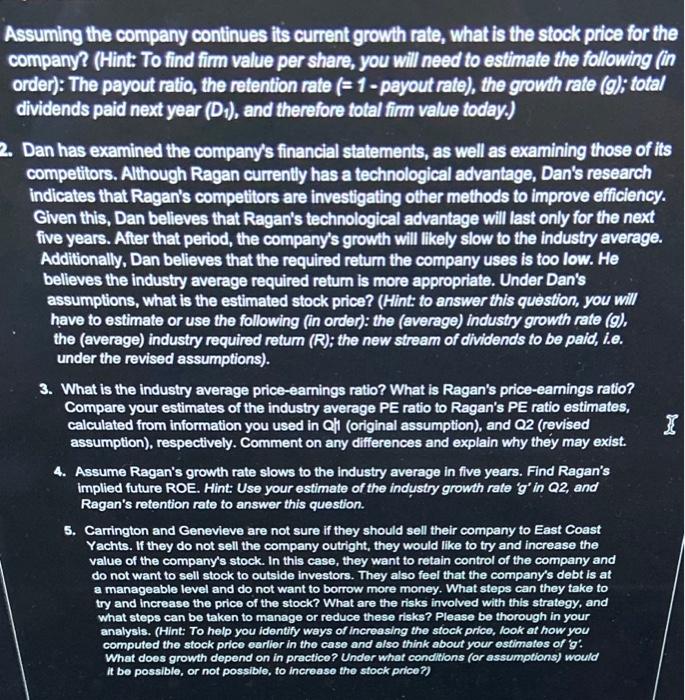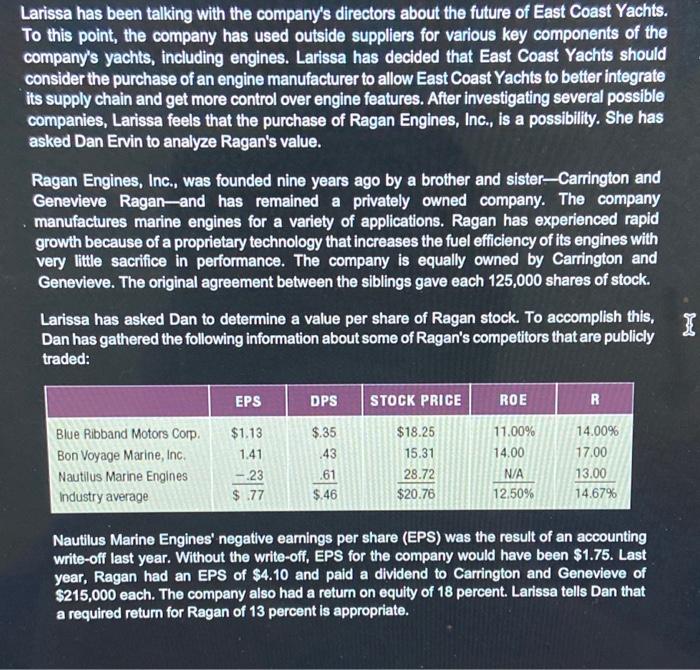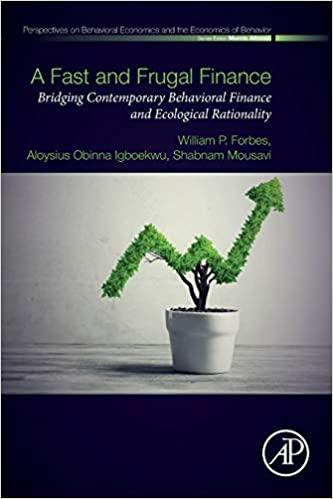

Assuming the company continues its current growth rate, what is the stock price for the company? (Hint: To find firm value per share, you will need to estimate the following (ifi order): The payout ratio, the retention rate ( =1 - payout rate), the growth rate (g); fotal dividends paid next year (Di), and therefore total firm value today.) Dan has examined the company's financial statements, as well as examining those of its competitors. Athough Ragan currently has a technological advantage, Dan's research indicates that Ragan's competitors are investigating other methods to improve efficiency. Given this, Dan believes that Ragan's technological advantage will last only for the next five years. After that period, the company's growth will ilkely slow to the industry average. Additionally, Dan believes that the required return the company uses is too low. He believes the industry average required retum is more appropriate. Under Dan's assumptions, what is the estimated stock price? (Hint: to answer this question, you will have to estimate or use the following (in order): the (average) industy growth rate (g), the (average) industry required retum (R); the new stream of dividends to be paid, i.e. under the revised assumptions). 3. What is the industry average price-earnings ratio? What is Ragan's price-earnings ratio? Compare your estimates of the industry average PE ratio to Ragan's PE ratio estimates, calculated from information you used in Qh (original assumption), and Q2 (revised assumption), respectively. Comment on any differences and explain why they may exist. 4. Assume Ragan's growth rate slows to the industry average in five years. Find Ragan's implied future ROE. Hint: Use your estimate of the industry growth rate ' g ' in Q2, and Ragan's retention rate to answer this question. 5. Carrington and Genevieve are not sure if they should sell their company to East Coast Yachts. If they do not sell the company outright, they would like to try and increase the value of the company's stock. In this case, they want to retain control of the company and do not want to sell stock to outside investors. They also feel that the company's debt is at a manageable level and do not want to borrow more money. What steps can they take to try and increase the price of the stock? What are the risks involved with this strategy, and What steps can be taken to manage or reduce these risks? Please be thorough in your analysis. (Hint: To help you identify ways of increesing the stock price, look at how you computed the stock price earlior in the case and also think about your estimates of ' g : What does growth depend on in practice? Undor what conditions (or assumptions) would it be possible, or not possible, to increaso the stock price? arissa has been talking with the company's directors about the future of East Coast Yachts. Io this point, the company has used outside suppliers for various key components of the company's yachts, including engines. Larissa has decided that East Coast Yachts should consider the purchase of an engine manufacturer to allow East Coast Yachts to better integrate its supply chain and get more control over engine features. After investigating several possible companies, Larissa feels that the purchase of Ragan Engines, Inc., is a possibility. She has asked Dan Ervin to analyze Ragan's value. Ragan Engines, Inc., was founded nine years ago by a brother and sister-Carrington and Genevieve Ragan-and has remained a privately owned company. The company manufactures marine engines for a variety of applications. Ragan has experienced rapid growth because of a proprietary technology that increases the fuel efficiency of its engines with very little sacrifice in performance. The company is equally owned by Carrington and Genevieve. The original agreement between the siblings gave each 125,000 shares of stock. Larissa has asked Dan to determine a value per share of Ragan stock. To accomplish this, Dan has gathered the following information about some of Ragan's competitors that are publicly traded: Nautilus Marine Engines' negative earnings per share (EPS) was the result of an accounting write-off last year. Without the write-off, EPS for the company would have been $1.75. Last year, Ragan had an EPS of $4.10 and paid a dividend to Carrington and Genevieve of $215,000 each. The company also had a return on equity of 18 percent. Larissa tells Dan that a required return for Ragan of 13 percent is appropriate. Assuming the company continues its current growth rate, what is the stock price for the company? (Hint: To find firm value per share, you will need to estimate the following (ifi order): The payout ratio, the retention rate ( =1 - payout rate), the growth rate (g); fotal dividends paid next year (Di), and therefore total firm value today.) Dan has examined the company's financial statements, as well as examining those of its competitors. Athough Ragan currently has a technological advantage, Dan's research indicates that Ragan's competitors are investigating other methods to improve efficiency. Given this, Dan believes that Ragan's technological advantage will last only for the next five years. After that period, the company's growth will ilkely slow to the industry average. Additionally, Dan believes that the required return the company uses is too low. He believes the industry average required retum is more appropriate. Under Dan's assumptions, what is the estimated stock price? (Hint: to answer this question, you will have to estimate or use the following (in order): the (average) industy growth rate (g), the (average) industry required retum (R); the new stream of dividends to be paid, i.e. under the revised assumptions). 3. What is the industry average price-earnings ratio? What is Ragan's price-earnings ratio? Compare your estimates of the industry average PE ratio to Ragan's PE ratio estimates, calculated from information you used in Qh (original assumption), and Q2 (revised assumption), respectively. Comment on any differences and explain why they may exist. 4. Assume Ragan's growth rate slows to the industry average in five years. Find Ragan's implied future ROE. Hint: Use your estimate of the industry growth rate ' g ' in Q2, and Ragan's retention rate to answer this question. 5. Carrington and Genevieve are not sure if they should sell their company to East Coast Yachts. If they do not sell the company outright, they would like to try and increase the value of the company's stock. In this case, they want to retain control of the company and do not want to sell stock to outside investors. They also feel that the company's debt is at a manageable level and do not want to borrow more money. What steps can they take to try and increase the price of the stock? What are the risks involved with this strategy, and What steps can be taken to manage or reduce these risks? Please be thorough in your analysis. (Hint: To help you identify ways of increesing the stock price, look at how you computed the stock price earlior in the case and also think about your estimates of ' g : What does growth depend on in practice? Undor what conditions (or assumptions) would it be possible, or not possible, to increaso the stock price? arissa has been talking with the company's directors about the future of East Coast Yachts. Io this point, the company has used outside suppliers for various key components of the company's yachts, including engines. Larissa has decided that East Coast Yachts should consider the purchase of an engine manufacturer to allow East Coast Yachts to better integrate its supply chain and get more control over engine features. After investigating several possible companies, Larissa feels that the purchase of Ragan Engines, Inc., is a possibility. She has asked Dan Ervin to analyze Ragan's value. Ragan Engines, Inc., was founded nine years ago by a brother and sister-Carrington and Genevieve Ragan-and has remained a privately owned company. The company manufactures marine engines for a variety of applications. Ragan has experienced rapid growth because of a proprietary technology that increases the fuel efficiency of its engines with very little sacrifice in performance. The company is equally owned by Carrington and Genevieve. The original agreement between the siblings gave each 125,000 shares of stock. Larissa has asked Dan to determine a value per share of Ragan stock. To accomplish this, Dan has gathered the following information about some of Ragan's competitors that are publicly traded: Nautilus Marine Engines' negative earnings per share (EPS) was the result of an accounting write-off last year. Without the write-off, EPS for the company would have been $1.75. Last year, Ragan had an EPS of $4.10 and paid a dividend to Carrington and Genevieve of $215,000 each. The company also had a return on equity of 18 percent. Larissa tells Dan that a required return for Ragan of 13 percent is appropriate








